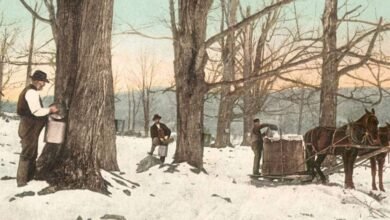Culinary History: Charles Dickens, Delmonico’s & A Club of Angry Women


 Charles Ranhöfer (1836-1899) was born in 1836 in St Denis, a northern suburb of Paris known for its Abbey-Basilica, the burial place of French Royals. Charles would become a “king” in his own right. As his father owned a restaurant and his grandfather had been a noted chef, it seemed natural to follow in their footsteps. The family descended from the Alsace.
Charles Ranhöfer (1836-1899) was born in 1836 in St Denis, a northern suburb of Paris known for its Abbey-Basilica, the burial place of French Royals. Charles would become a “king” in his own right. As his father owned a restaurant and his grandfather had been a noted chef, it seemed natural to follow in their footsteps. The family descended from the Alsace.
At age twelve, Charles was sent to Paris to learn the art of pastry-making. After completing his apprenticeship he progressed quickly in his career, working as head baker at a Parisian restaurant at the age of fifteen. Soon after he was employed by Thierry, Prince de Hénin, Count of Alsace, where he learned to prepare and organize grand banquets. In 1856, the twenty-year-old took the decision to move to America.
Celebrity Chef
Ranhöfer (he soon dropped the umlaut from his name) first worked for a Russian diplomat in the city of New York, then for a restaurant in Washington DC and a private family in New Orleans where he learned Creole cuisine. In 1860, he briefly returned to France where he spent a winter at the Tuileries Palace, arranging festive occasions at the Court of Napoleon III.
He returned to New York in 1861 to manage the kitchen of the elegant Maison Doree (just south of Union Square), but in 1862 he was hired by Lorenzo Delmonico as chef to the family restaurant, by then located on Fourteenth Street & Fifth Avenue.
The house dated back to 1827 when the Italian-Swiss brothers Giovanni [John] and Pietro [Peter] Delmonico rented a six-table coffee & pastry shop at 23 William Street, Manhattan, which they turned into an eatery named Delmonico’s.

 Lorenzo was born in March 1813 in Ticino at the southernmost canton of Italian-speaking Switzerland. The area was known for its chestnuts and the mass exodus of hoteliers and waiters who worked in cafés and restaurants in Paris, London or New York City. Lorenzo joined the restaurant founded by his uncles. He was the genius behind the extraordinary rise of Delmonico’s.
Lorenzo was born in March 1813 in Ticino at the southernmost canton of Italian-speaking Switzerland. The area was known for its chestnuts and the mass exodus of hoteliers and waiters who worked in cafés and restaurants in Paris, London or New York City. Lorenzo joined the restaurant founded by his uncles. He was the genius behind the extraordinary rise of Delmonico’s.
Following Ranhofer’s appointment, the family ran a Parisian style restaurant with an enormous wine cellar, white tablecloths (the first American outlet to do so), an army of waiters and a female cashier, offering “exotic” dishes to an elite clientele.
Except for a three year period between 1876 and 1879, when Ranhofer returned to France to run the Hôtel American near Paris, he remained with Delmonico’s the rest of his life. He excelled at presenting sumptuous dinners for special occasions, including Presidential banquets.
He created numerous new recipes, such as Baked Alaska to celebrate the Alaska Purchase in 1867. He was the first to serve Lobster Newberg, Eggs Benedict and other gastronomic novelties. The reputation of Delmonico’s as the city’s finest restaurant was built during Ranhofer’s reign which lasted to his death in 1899.
Men Only
Ranhofer catered to the pomp and opulence of the Gilded Age. The restaurant’s name was associated with lavish banquets given to honor prominent men (British railway tycoon Morton Peto splashed out a fortune of $30,000 to host a dinner party in 1865). And for a while it was men and men only who participated in such celebrations.
At the time, American society was segregated by sex and the streets were a male sphere. Females were not permitted to enter restaurants or hotels on their own. Early eateries either barred or banned women without a male escort from their dining areas.
Management sometimes reserved special rooms for women, known as “Ladies Ordinaries,” thus providing a venue where respectable women could dine alone or in company of other females, being protected from unwanted male gazes or advances. Such areas for “unescorted” ladies often had separate side entrances.
Charles Dickens (1812-1870) had arrived in Boston on November 19, 1867, to start a second tour of the United States. He spent several days at the Parker House Hotel recuperating from the voyage.
In spite of his failing health, he was facing a tiresome itinerary which included Boston, Providence, Hartford, New Haven, New York City, Philadelphia, Baltimore, Washington DC (where he had a meeting with President Andrew Johnson), Albany, Rochester, Syracuse and Buffalo.
When the novelist reached New York, the City’s Press Club organized a dinner in his honor on April 18, 1868, at Delmonico’s where two hundred guests sat down to a “Feast of Reason and a Flow of Soul.” Ranhofer’s menu included such delicacies as “Agneau farci à la Walter Scott” (stuffed lamb) and “Cotelettes (cutlets) à la Fenimore Cooper.”
The diners were all male. Public banquets were for men only. Club officials generously offered those ladies who wanted to join the event an opportunity to eat behind a curtain, but the suggestion was rejected. They took effective action instead.
Jane Croly Luncheon
Jane Cunningham Croly (1829-1901) was born in December 1829 in Market Harborough, Leicestershire, where her father was a Unitarian preacher. His unpopular views led to the stoning of the family home in 1841. Her parents decided to move the family to the city of New York. Jane grew up in Poughkeepsie and Wappinger’s Falls, in Dutchess County, NY.
She would become a ground-breaking journalist. In 1855, she joined the staff of the New York Tribune and was one of the first women in the United States to write a syndicated column under the name “Jenny June.” By 1860, she and her husband worked for the New York World.
When her partner contracted Bright’s disease (inflammation of the kidneys, now referred to as nephritis) in 1879, she financially supported her family of four children through her work as a journalist and editor. After his death in 1889, she was appointed Professor of Journalism at Rutgers University, New Brunswick, becoming the first American woman to teach news writing.

 Croly applied to attend the Dickens dinner, but the Press Club refused her access even though she was an active member of the organization and a respected journalist. In response to her disdainful rejection, Croly founded the first American women’s club which she named “Sorosis” (a scientific term for the group of budding flowers that form a fruit, derived from the Latin “soror” or sister).
Croly applied to attend the Dickens dinner, but the Press Club refused her access even though she was an active member of the organization and a respected journalist. In response to her disdainful rejection, Croly founded the first American women’s club which she named “Sorosis” (a scientific term for the group of budding flowers that form a fruit, derived from the Latin “soror” or sister).
She recruited fellow professional women and enlisted the support of Horace Greeley, the powerful editor of the Tribune. Jane approached Lorenzo Delmonico and asked him to host her “risky and outré” group of unaccompanied women for a lunch.
Like other leading restaurants in Manhattan, Delmonico’s did not serve women unless escorted by men. In spite of convention, its owner approved the request and provided a dining room for the first meeting of the Sorosis Club where members were served by Charles Ranhofer.
The Jane Croly Luncheon took place on April 20, 1868, two days after the Dickens event. For the house to make a stand about women patrons arriving without male escorts, was a ground-breaking move. Delmonico’s became the standard location of the Club’s monthly meetings.
In founding Sorosis, Croly wanted to improve female status both in the private and public spheres. As the first club entirely run and administered by American women, it attracted ample attention (and censure). Her ultimate goal was to inspire “womanly self-respect and self-knowledge.” Regular meetings offered a chance for women with similar ambitions to socialize, gain self-confidence and make contacts for career advancement.
The Club flourished and by the end of its first year eighty-three female historians, writers, artists and physicians attended its meetings. Refusing to align itself with any other group or cause, it campaigned for education and sponsored scholarships for female art students.
Members demanded improved working conditions and better healthcare for women. Sorosis inspired a slew of similar clubs across America and sparked the emergence of women into the public domain.
Crody brought together delegates from more than sixty women’s clubs in 1890 to form the “General Federation of Women’s Clubs.” Its mission was to encourage them to work together on lobbying efforts for reforms in areas of health, education and conservation. It set in motion the power of a previously untapped pool of female talent that would reshape American society. And all that was down to a visit by Charles Dickens.
Past & Future
The wider impact of Sorosis and similar clubs or movements is difficult to measure, but there were clear indications of social change. The emergence of the “Community Cookbook” was one such signs.
Beginning in the 1870s, these collections were compiled by women for the purpose of raising money for a local church or hospital, for the establishment of a kindergarten or the foundation of a public library. Cooking for social causes.
Dinners in American public places, both its preparation and its consumption, was up until then largely a male affair. All the famous chefs were men; meals and banquets were male-only occasions. Yet, the first successful cooking schools were founded by women.
Maria Parloa was a Massachusetts-born lecturer on nutrition topics and author of books on cooking and housekeeping. The founder of two cooking schools, she pushed for an understanding of “domestic science” (now labeled home economics).
Maria was interested in topics of food and social well-being, giving lectures that were well received. It motivated her in October 1877 to establish “Miss Parloa’s School of Cooking” at 174 Tremont Street, Boston (preceding by two years the Boston Cooking School founded by the city’s Women’s Education Association).
In 1882, she closed her institute for financial reasons and moved to Manhattan where she opened “Miss Parloa’s School of Cooking” at 222 East Seventeenth Street. In addition to regular teaching courses, she offered free instruction to “immigrant girls” – the chef acting as social reformer. Maria’s school was not the first cooking institute to open in New York City.
Juliet Corson (1841-1897) was also born in Massachusetts, but lived in New York City from the time she was six. Because of her fragile health, she was educated privately. She became librarian for the Working Woman’s Library and later wrote a regular column in the New York Leader on topics of interest to women, including the economics of nutritional cookery.

 In 1873/4, Corson was Secretary of the “Free Training School for Women” which provided lessons in bookkeeping, reading and sewing to which she added a cooking course in 1874. Two years later she founded the “New York School of Cookery” at St Mark’s Place, East Village, charging tuition on a sliding scale so that no one would be turned away.
In 1873/4, Corson was Secretary of the “Free Training School for Women” which provided lessons in bookkeeping, reading and sewing to which she added a cooking course in 1874. Two years later she founded the “New York School of Cookery” at St Mark’s Place, East Village, charging tuition on a sliding scale so that no one would be turned away.
Her first book was The Cooking School Manual (1877) in which she set forth to answer two questions, “How well can we live, if we are moderately poor?” and “How to make the most wholesome and palatable dishes at the least possible cost.”
That same year she distributed a booklet entitled Fifteen Cent Dinners for Families of Six with the intent to help poor people learn how to cook on tight budgets. Juliet ran New York City’s first successful cooking school until 1883, when she was forced to step back for health reasons.
She must have been delighted (and amused) when in 1881 the French Consul General at New York asked Juliet Corson to inform him about her works and methods for the purpose of adapting them to the needs of the educational system in France. The French were no longer the absolute masters of cuisine.
Juliet Corson was honored for her work over many decades at the World’s Columbian Exposition in Chicago in 1893 when she presided over the exhibit of the New York Cooking School in the gallery of the building of Manufactures and Liberal Arts. The extent to which food was highlighted as a precious commodity there underlined what progress had been made in social awareness and education.
A year later, Ranhofer collected all his exclusive recipes in a cookbook, a thousand-page tome called The Epicurean, “one of the most complete treatises of the kind ever published,” according to the New York Times.
His book was a testimony to the culinary excesses of the past, whilst Corson’s contribution signaled restraint and a future of moderation.
Illustrations, from above: Detail from Alfred Henry Maurer’s “In a Café-Restaurant,” 1905 (Hermitage, St Petersburg); Lorenzo Delmonico, ca. 1884; and a cartoon parody of elites feasting at Delmonico’s while the hungry poor beg for a handout, New York World, October 30, 1884.
Source link





